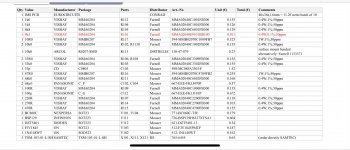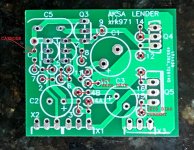Replaced Q4 in both channels, re-installing it on reverse side of PCB and added a heatsink. Its now running at around 42 degrees. Noise persists as previously. I tried running the Meanwell SMPS with PO89ZB inline filter (around 40V input to CLC filter, no DC-DC converter) to eliminate possible noise from DC-DC converter. Same result. I then tried a Sigma 11 linear PS (24V) feeding into DC-DC converter, in case noise may have been emanating from Meanwell SMPS. Same result. So I'm now convinced that the noise is being generated on DB's and is probably thermal as is doesn't occur until 30-40 minutes after switching on. This is odd because temperatures are not excessive anywhere on the boards. As noted earlier, the only variation from the BOM that I made is DN2535 in place of DN2540. This is running at about 35 degrees, hardly warm enough to cause stress.Hi Rolo,
Sorry you are having so much trouble. It sounds like a thermal problem and all I can suggest is to add a small screw on stamped aluminum heatsink to the mosfet and BJT.
Can you confirm that the cathode on your diode faces the correct direction (towards the “C”)?
View attachment 1097123
Another way to test if thermal effect is to set a fan blowing across the DBs. If the problem does not come up after 20min, heat is the culprit.
In the absence of other explanations or reasons for this problem, I can only assume that either there are faulty components in same or similar positions on boards of both channels (unlikely), or I have made an error when stuffing the boards, with wrong component value(s), or wrong placement, or both. However, due to the compact size of the boards and close proximity of the components to each other, this is difficult to ascertain with certainty and the boards would need to be at least partially disassembled to check. For now, I will wait for new SMT boards DB's to arrive, build these up and (hopefully) get the preamp running properly before persuing with this issue.
Thanks again to all for your assistance.
Speculating as a noob here, the only component on the main board (common to the two daughter boards), that could possibly fail/misbehave is the IRF610. Maybe check the temperature of this component. Cannot make out the actual size of the IRF610 heatsink on the pic of the main board. Pure speculation.
X - recording the noise would be problematic with my current equipment set up. Bad part(s) is a definite possibility. Noise is present in both channels and more or less at same level. This implies something common to both channels on main board, or same/similar parts on DB's. As previously stated, I have tried inserting V+ after R147 thereby bypassing cap Mx and CRCRC filter. So logically, problem must lie downstream from this.
It has just occurred to me there is a possibility C134 and 135 may be the culprits. I'm using 220uF 50V Silmic II's. At 48V, they are probably running close to their maximum rating. Although they aren't getting hot (or even warm), maybe they are being pushed hard enough to stress after a certain time?? I'll change them for higher voltage caps and see if anything changes.
twocents - IRF610 has previously been changed as it was one of the first things I suspected. I don't think its doing a lot of work as temp doesn't rise above ambient with 25mm heatsink.
It has just occurred to me there is a possibility C134 and 135 may be the culprits. I'm using 220uF 50V Silmic II's. At 48V, they are probably running close to their maximum rating. Although they aren't getting hot (or even warm), maybe they are being pushed hard enough to stress after a certain time?? I'll change them for higher voltage caps and see if anything changes.
twocents - IRF610 has previously been changed as it was one of the first things I suspected. I don't think its doing a lot of work as temp doesn't rise above ambient with 25mm heatsink.
Hi Rolotube,
Thanks for trying out all the debug steps. I am frankly stumped. The only thing different is the DN2530 being used. 50v electrolytic caps being used at 48v might be close but usually won’t take 30min to break down. All I can suggest is use a fan to cool it and if the effect goes away, it’s a source of heat somewhere. It might be heat proximity to a cap.
Thanks for trying out all the debug steps. I am frankly stumped. The only thing different is the DN2530 being used. 50v electrolytic caps being used at 48v might be close but usually won’t take 30min to break down. All I can suggest is use a fan to cool it and if the effect goes away, it’s a source of heat somewhere. It might be heat proximity to a cap.
I'm stumped as well! Changed C124, 134, 126, 136 to 220uF 100V Elna Cerafine. There was no change in noise level. All caps on main daughter boards are now operating well below their rated voltage. No components except Q4 and 5 are operating much above ambient room temperature (~20-25 degrees) according to my non-contact thermometer. So I doubt fan cooling would make a lot of difference, but may be worth giving it a go.
Re parts orientation and placement on DB's, I cannot categorically say that it is correct because the orientation of some the resistors is such that values cannot be read. The only way to confirm is to systematically remove parts until their orientation and value have been checked. Given the small size and very close placement of the components, this is likely to be a challenging exercise, but it may be the only way to locate and confirm the source of the noise.
Re parts orientation and placement on DB's, I cannot categorically say that it is correct because the orientation of some the resistors is such that values cannot be read. The only way to confirm is to systematically remove parts until their orientation and value have been checked. Given the small size and very close placement of the components, this is likely to be a challenging exercise, but it may be the only way to locate and confirm the source of the noise.
Where in the world do you reside? I could send you a pair of working daughter boards from South Africa, but the shipping will probably cost more than just re-building another pair. PM me if you are interested. Anyway, I hope this problem can be resolved, even if you plan to build and use smd boards.
Only other thing I can think of is the source. Maybe this preamp exposes noise from the source?
Only other thing I can think of is the source. Maybe this preamp exposes noise from the source?
Australia. Thanks for your kind offer. As you mention, shipping is likely to be more than cost of re-building boards. I believe the cause of the problem with these DB's needs to be determined before building new ones, whether TH or SMT, or else I may be repeating the same mistake! So I've decided to disassemble one to check for incorrect placement and/or faulty components. Given that the noise occurs in both channels, it's likely that if the cause can be found in one, it will be the same in the other. Hopefully this will solve the problem, or at least, shed more light on it.
A long time ago I had a problem with a TH board. And after 5 hours of debugging it unsuccessfully, I built a new one from scratch and that fixed it. My problem was that it would not bias the output current correctly.
Sometimes abandoning is good. But as you say, both boards afflicted so it’s a systemic problem.
Sometimes abandoning is good. But as you say, both boards afflicted so it’s a systemic problem.
Systemic problem indeed. Today I built up SMT DB's using MELF parts. Worked perfectly from the get go (critical voltages and temperatures all normal) and sound great, but the noise persists exactly as before with TH DB's. I've now replaced and/or bypassed every component on both main board and DB's, with exception of output bypass caps (Wima MKP). So its looking more like the problem is not with the preamp per se, but possibly with some weird interaction between the AL and my power amp (25W choke loaded THF51S SIT source follower). The really odd thing is that individually, both perform perfectly well. That is, the AL preamp is dead quiet when driving another power amp or used as a headphone amp, and the power amp is dead quiet with any other preamp I've tried. The nature of the noise and hash is unlike anything I've heard before. It begins after about 30 to 40 minutes of normal (totally silent) operation and slowly builds, beginning in the left channel and eventually reaches a maximum in both channels after a further five minutes or so, then remains more or less constant and at similar level in both channels. Sounds somewhat like RFI but 50Hz hum (and possibly harmonics?) is also clearly audible.
My knowledge of potential interactions between system components is very limited, but given that the AL preamp and SIT power amp both have frequency responses that extend to 1MHz or higher, I was wondering whether there could be some kind of interaction (oscillation?) at audible and/or higher frequencies that is producing the noise. Perhaps examination with a DSO might shed some light on this. The saga continues..........
My knowledge of potential interactions between system components is very limited, but given that the AL preamp and SIT power amp both have frequency responses that extend to 1MHz or higher, I was wondering whether there could be some kind of interaction (oscillation?) at audible and/or higher frequencies that is producing the noise. Perhaps examination with a DSO might shed some light on this. The saga continues..........
- Home
- Group Buys
- AKSA's Lender Preamp with 40Vpp Ouput GB

